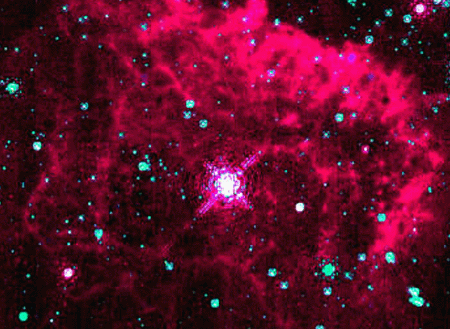Star Life Cycles - The Largest Stars
Stars and NebulaeIndex
Interstellar Clouds Questions Credits Links Michael Gallagher August 2002 July 2007 |
 The Pistol Star, a 100 solar mass star near the Milky Way's centre. Hubble Space Telescope The largest stars have the most fuel, but the shortest lives, for they fuse hydrogen at prodigous rates. Their strong stellar winds blast their outer atmospheres into surrounding space. Once their hydrogen is exhausted, they quickly consume all other fusible elements. With no atmosphere to expand, they do not pass through a red giant phase. When all fuel is spent, if sufficient mass remains in the core, a collapse that nothing can resist follows and a black hole* is formed. The speed of the collapse generates gigantic supernovae explosions that hurl immense masses of dust and gas into surrounding space. Very Large Star Details Mass: 40 to 120 Suns Surface Temperature: 20,000° to 100,000° K Lifetime: A few million years End: A supernova explosion, a debris cloud and a neutron star or black hole. Material is lost from the core during the supernova explosion. The actual end point is dependent upon the mass of the core at the final stage of the collapse. It the remnant core mass is 2 or 3 Suns a neutron star results. If the core mass is greater, a black hole* results.
*Note: The physics of black hole formation is imperfectly
understood and hotly contested.
|
